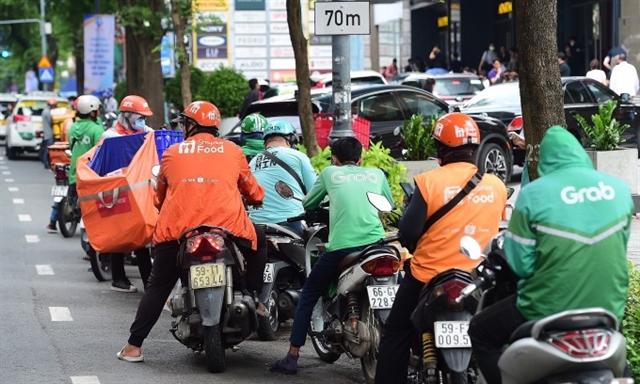 Economy
Economy

 |
| Motorbike drivers of ride-hailing and delivery platforms wait on a street in HCM City. — VNA/VNS Photo |
HCM CITY — The ride-hailing job market in HCM City has seen increasing competition in already harsh conditions as many laid-off factory workers have taken up the job, according to experts.
Phạm Mi Sen, a motorbike driver for Grab and vice chairman of the union of motorbike taxi ride-hailing app drivers in Bình Tân District, said a large number of people who lost their jobs at factories have joined the workforce, and the number of applicants has been so large that ride-hailing companies have had to delay putting new drivers to work.
Many people were recruited two months ago but have not seen their accounts activated to receive ride bookings yet, Sen said at a conference on digital work platforms held by Fairwork Vietnam last week.
"A new driver means the rest of us lose some customers and have to compete harder for rides," Sen said.
He calculated that a driver needs to work 50 per cent more to increase their income by just 8 per cent. Many people drive day and night, having quick meals right on their bikes, to earn enough for a living.
The job has become even harder while the companies, amid the surplus of manpower, have tightened their regulations about driver service, Sen said.
"Drivers who receive customer complaints twice on the app will be suspended. They will be fired permanently after the third complaint," he said.
Earlier, a survey by the Vietnam Labour Confederation, the Center for Health Consultation and Community Development, and Oxfam found that a Grab motorbike driver makes an average of VNĐ7 million (US$284.84) a month.
Around two-thirds of the surveyed drivers are married and 60 per cent of them are taking care of at least two other people.
The survey revealed a stressful working environment, where 95 per cent of the drivers have to work six to 12 hours a day, with no days off, under high pressure of having to be on time.
Most of them have had to work in difficult conditions, including bad weather and heavy traffic. They also have to deal with the loss and damage of delivered goods, difficult demands from customers, and even sexual harassment, according to the survey.
Sen said drivers are labeled as partners in contracts with ride-hailing companies, but they are the ones "bearing all the consequences."
As business partners, drivers are subject to corporate tax, besides having to share 20 per cent of the fares with the companies.
But the companies hold all power when it comes to setting the terms of cooperation. The contracts allow the companies to suspend or end cooperation with drivers at any time.
Sen said theoretically, ride-hailing app drivers have flexible working hours and can turn off the app when they do not want to work. But the reality is one's account will not receive any ride bookings after they turn off the app for a couple days.
"Ride booking restrictions are the companies' way to force us to work non-stop," Sen said.
Dr. Đỗ Hải Hà, a member of Fairwork Vietnam, said around 600,000 drivers joined ride-hailing app businesses between 2014 and 2019.
Hà said relations between the drivers and the companies have not been clearly defined, which has prevented the drivers from receiving proper rights.
The network's research found that no ride-hailing platforms in Việt Nam could provide firm evidence that all its drivers earn more than the minimum wage, which is VNĐ4.68 million a month in HCM City.
The drivers have to pay for their own motorbikes, phone and medical insurance. The companies hardly even cover their accident insurance.
Việt Nam’s ride-hailing industry revenues could reach US$4 billion by 2025, while the industry has witnessed high demand and new entrants.
Beginning in Việt Nam in 2014, Việt Nam’s car-hailing service market has seen a boom with more than 20 different platforms.
It is reported that Việt Nam’s ride-hailing service market earned revenue of $2.4 billion in 2021 and reached an average growth rate of 30-35 per cent annually since 2015. The growth rate of users who use ride-hailing apps ranks second after the e-commerce market in the country.
Between 2020 and 2021, during the fourth wave of the COVID-19 pandemic, social distancing measures sometimes forced ride-hailing applications to freeze completely. However, ride-hailing platforms have been expanded with services such as online food and goods delivery and electronic payment due to the change in habits of Vietnamese consumers, so food delivery services have become increasingly popular, especially mobile delivery apps.
According to Statista (a German company specialising in market and consumer data), the total market share of the three largest ride-hailing companies in Việt Nam - Grab, Gojek and Be - reached nearly 99 per cent in 2020.
Experts said that competition on fees and service quality, diversified platforms offered certain benefits for users.
They said users enjoy more benefits, noting that this creates challenges and great pressure for potential companies that want to join this market. — VNS




